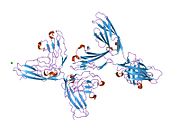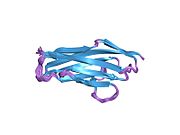Neural cell adhesion molecule
| NCAM1 | ||||||
|---|---|---|---|---|---|---|
| UniProt | ||||||
| RefSeq (mRNA) |
| |||||
| RefSeq (protein) | ||||||
| Location (UCSC) | Chr 11: 112.96 – 113.28 Mb | Chr 9: 49.41 – 49.71 Mb | ||||
| PubMed search | [3] | [4] | ||||
| View/Edit Human | View/Edit Mouse |
Neural cell adhesion molecule (NCAM), also called CD56, is a homophilic binding glycoprotein expressed on the surface of
Forms, domains and homophilic binding
NCAM is a glycoprotein of Immunoglobulin (Ig) superfamily.
At least 27 alternatively spliced NCAM mRNAs are produced, giving a wide diversity of NCAM isoforms.
- NCAM-120kDa (GPI anchored)
- NCAM-140kDa (short cytoplasmic domain)
- NCAM-180kDa (long cytoplasmic domain)
The extracellular domain of NCAM consists of five
Homophilic binding occurs between NCAM molecules on opposing surfaces (trans-) and NCAM molecules on the same surface (cis-)1. There is much controversy as to how exactly NCAM homophilic binding is arranged both in trans- and cis-. Current models suggest trans- homophilic binding occurs between two NCAM molecules binding antiparallel between all five Ig domains or just IgI and IgII. cis- homophilic binding is thought to occur by interactions between both IgI and IgII, and IgI and IgIII, forming a higher order NCAM multimer. Both cis- and trans- NCAM homophilic binding have been shown to be important in NCAM “activation” leading to neurite outgrowth.
Minor exons
Another layer of complexity is created by the insertion of other "minor" exons in the NCAM transcript. The two most notable are:
- the VASE (VAriable domain Spliced Exon) exon which is thought to correlate with an inhibition of the neurite outgrowth promoting properties of NCAM.
- the MSD (Muscle Specific Domain), which is thought to play a positive role in myoblast fusion.[8] In skeletal muscle it is found in all three NCAM isoforms, increasing their MW, giving NCAM-125, NCAM-145, and NCAM-185 isoforms, but is most commonly found in the NCAM-125 isoform.[8]
Posttranslational modification
NCAM exhibits
Expression in normal cells
The neural cell adhesion molecule NCAM1 appears on early
Later in development, NCAM1 (CD56) expression is found on various differentiated tissues and is a major CAM mediating adhesion among neurons and between neurons and muscle.
Function
NCAM is thought to signal to induce neurite outgrowth via the
In nerves, NCAM1 regulates homophilic (like-like) interactions between neurons and between neurons and muscle; it associates with
During
In
Pathology
In
- Normal cells that stain positively for CD56 include neuroendocrinetissues.
- Tumors that are CD56-positive are Ewing's sarcomafamily of tumors.
Cancer
A member of the NCAM superfamily, NCAM2 gene has been observed progressively downregulated in
Alzheimer's disease
NCAM2 is found in lower levels in hippocampal synapses of Alzheimer's disease sufferers and is found to be broken down by beta-amyloid.[13]
Rabies
NCAM has been identified as one of the target proteins for the rabies virus, allowing entry into the cell.[14]
Anti-NCAM therapy
NCAM has been used as a target molecule for experimental antibody-based immunotherapy. Successful radio-immunolocalisation of metastases was demonstrated after giving injections of NCAM-binding 123J-UJ13a or 131J-UJ13a radio-immunoconjugates to children with neuroblastoma. Patients with small cell lung cancer were treated with the anti-NCAM immunotoxin huN901-DM1 in two different clinical studies, revealing acceptable toxicity and signs of clinical response.[15]
References
- ^ a b c GRCh38: Ensembl release 89: ENSG00000149294 – Ensembl, May 2017
- ^ a b c GRCm38: Ensembl release 89: ENSMUSG00000039542 – Ensembl, May 2017
- ^ "Human PubMed Reference:". National Center for Biotechnology Information, U.S. National Library of Medicine.
- ^ "Mouse PubMed Reference:". National Center for Biotechnology Information, U.S. National Library of Medicine.
- PMID 28791027.
- ^ Pathology Outlines
- PMID 1996115.
- ^ PMID 13679364.
- S2CID 43042018.
- S2CID 22798537.
- PMID 17050727.
- ^ S2CID 24986454.
- PMID 26611261.
- S2CID 73468336.
- PMID 17949897.
External links
- Neural+Cell+Adhesion+Molecule at the U.S. National Library of Medicine Medical Subject Headings (MeSH)







